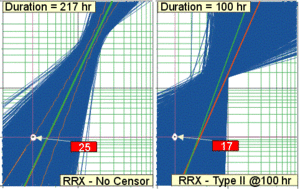Template:Example: Test Design Using Simulation
Test Design Using Simulation
Let us assume that a specific reliability specification states that at [math]\displaystyle{ T=10 }[/math] hr the reliability must be 99%, or [math]\displaystyle{ R(T=10)=99% }[/math] (unreliability = 1%), and at [math]\displaystyle{ T=20 }[/math] hr the reliability must be 90%, or [math]\displaystyle{ R(T=20)=90% }[/math] , at an 80% lower one-sided confidence level ( [math]\displaystyle{ L1S=80% }[/math] ).
One way to meet this specification is to design a test that will demonstrate either of these requirements at [math]\displaystyle{ L1S=80% }[/math] with the required parameters (for this example we will use the [math]\displaystyle{ R(T=10)=99% }[/math] @ [math]\displaystyle{ L1S=80% }[/math] requirement). With SimuMatic, we can specify the underlying distribution, distribution parameters (the Parameter Experimenter utility can be utilized), sample size on test, censoring scheme, required reliability and associated confidence level. From these inputs, SimuMatic will solve (via simulation) for the time demonstrated at the specified reliability and confidence level (i.e. [math]\displaystyle{ X }[/math] in the [math]\displaystyle{ R(T=X)=99% }[/math] @ [math]\displaystyle{ L1S=80% }[/math] formulation), as well as the expected test duration. If the demonstrated time is greater than the time requirement, this indicates that the test design would accomplish its required objective. Since there are multiple test designs that may accomplish the objective, multiple experiments should be performed until we arrive at an acceptable test design (i.e. number of units and test duration).
We start with a test design using a sample size of ten, with no censoring (i.e. all units to be tested to failure). We performed the analysis using RRX and 10,000 simulated data sets. The outcome is an expected test duration of 217 hr and a demonstrated time of 25 hr. This result is well above the stated requirement of 10 hr (note that in this case, the true value of T at a 50% CL, for R = 99%, is 40 hrs which gives us a ratio of 1.6 between true and demonstrated). Since this would demonstrate the requirement, we can then attempt to reduce the number of units or test time. Suppose that we need to bring the test time down to 100 hr (instead of the expected 217 hr). The test could then be designed using Type II censoring (i.e. any unit that has not failed by 100 hr is right censored) assuring completion by 100 hr. Again, we specify Type II censoring at 100 hr in SimuMatic, and we repeat the simulation with the same parameters as before. The simulation results in this case yield an expected test duration of 100 hr and a demonstrated time of 17 hr at the stated requirements. This result is also above our requirement The next figure graphically shows the results of this experiment. This process can then be repeated using different sample sizes and censoring schemes until we arrive at a desirable test plan.
